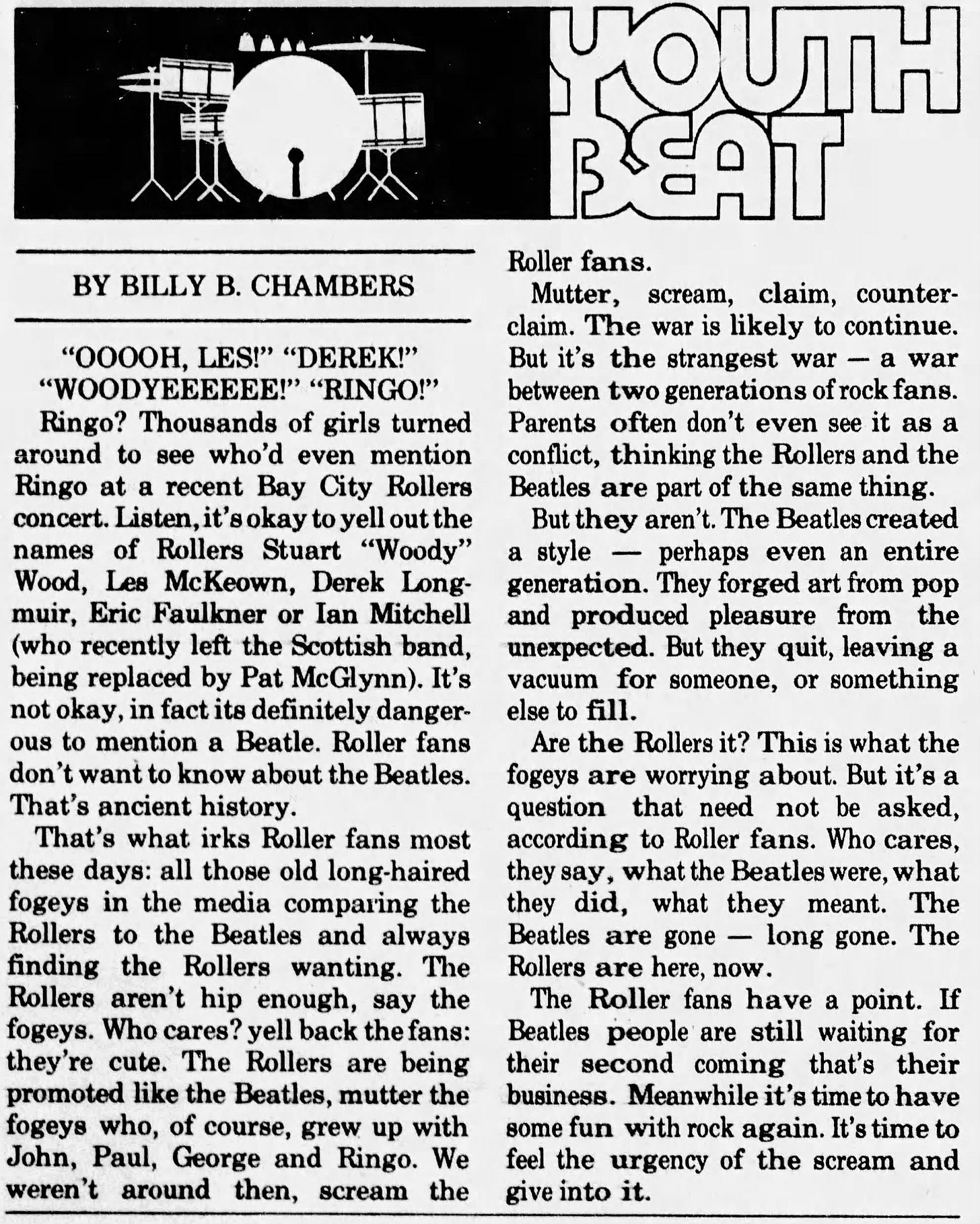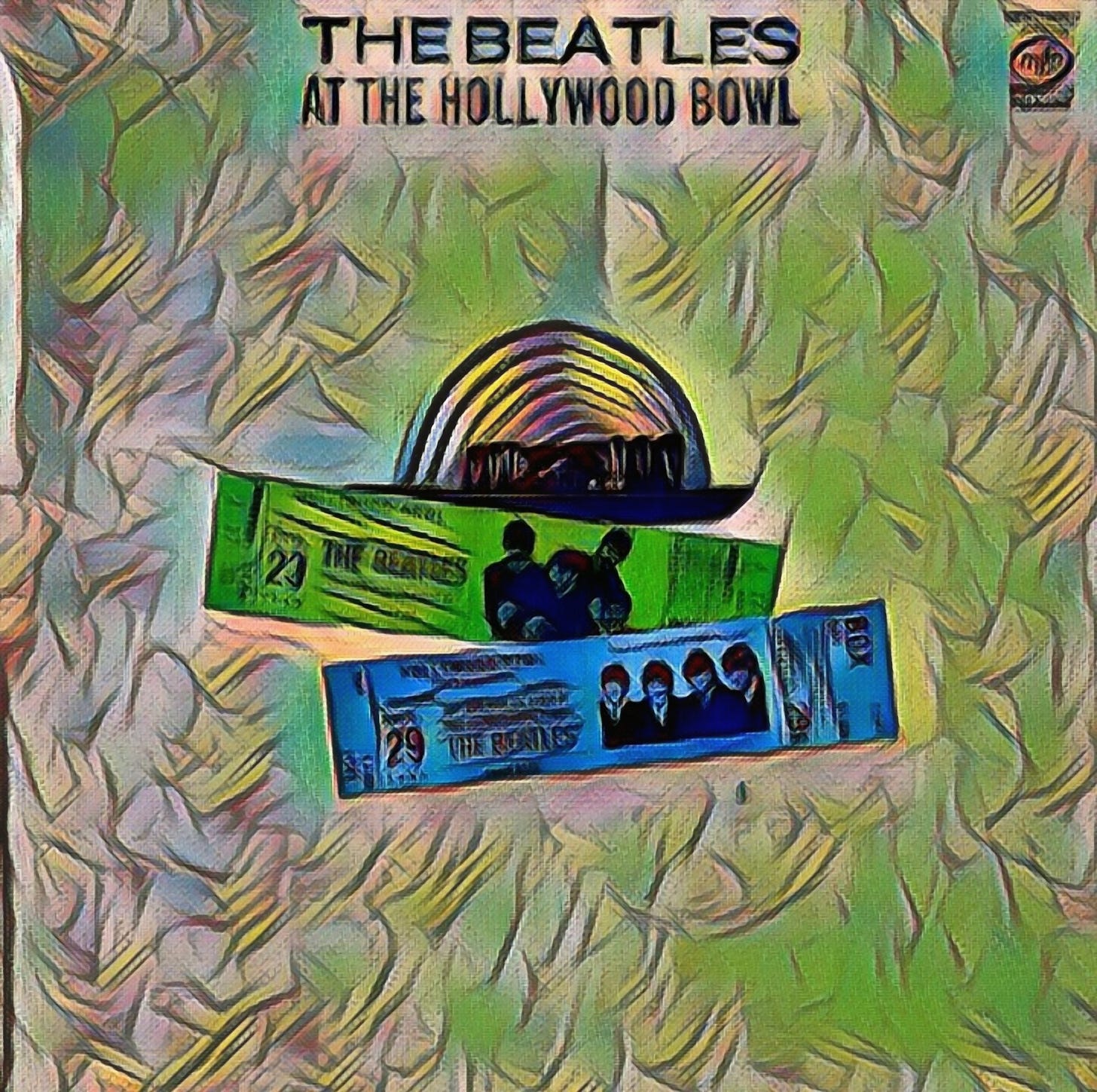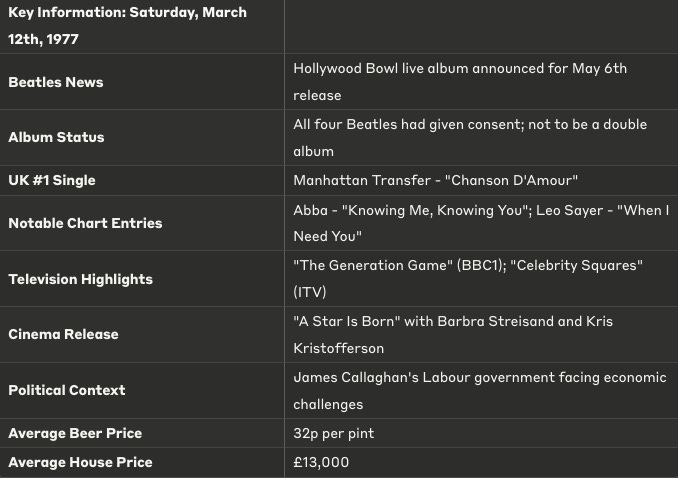In which our intrepid correspondent examines a seemingly ordinary day that revealed the continuing appeal of four lads who'd split up seven bloody years earlier...
It was the spring of '77, and while the Sex Pistols were busy shocking grannies nationwide and the Clash were about to release their debut album, the biggest music news of the week concerned a band that had ceased to exist before some punk fans had even started comprehensive school.
Yes, dear readers, on this drizzly March Saturday, as millions of Britons trudged through puddles to collect their copies of Melody Maker, they were greeted with the headline: "Beatles Live LP In May." The Fabs may have gone their separate ways in 1970, but they continued to haunt the cultural landscape like four surprisingly lucrative ghosts.
"STEP INSIDE, LOVE..."
The report confirmed what the rumour mill had been churning out for weeks—all four Beatles had finally given their consent to the release of recordings from their Hollywood Bowl concerts. The album would hit the shops on May 6th, backed by what Melody Maker described as "a massive advertising campaign on television," similar to the promotional blitz that accompanied 1976's "Rock 'N' Roll Music" compilation.
For those keeping score at home, this would be the fifth Beatles album to be released since their breakup. The grave-robbers at EMI/Capitol were proving themselves remarkably adept at squeezing blood from a stone—or perhaps more accurately, squeezing money from nostalgic record buyers who simply couldn't get enough of John, Paul, George, and the funny one with the big nose.
The Hollywood Bowl recordings had been gathering dust in the EMI vaults since 1964 and 1965. The tapes captured the Beatles at the height of Beatlemania, playing to screaming hordes of American teenagers whose collective volume often threatened to drown out the music entirely. The original plan had been to release them shortly after they were recorded, but producer George Martin deemed the sound quality too poor for commercial release.
So why now? Well, in a decade where nostalgia was rapidly becoming Britain's primary cultural export, Beatles product—any Beatles product—was guaranteed to shift units. The punters were gagging for it, even if it meant hearing "She Loves You" through what sounded like a pillow stuffed with ball bearings.
"YOU KNOW MY NAME, LOOK UP THE NUMBER"
It was George Martin himself who'd been tasked with making these recordings listenable. The maestro who had shaped the Beatles' sound from "Please Please Me" through to "Abbey Road" was now hunched over the mixing desk, attempting to separate the sound of four young Liverpudlians playing their hearts out from the sound of 17,000 American teenagers losing their minds. A sonic challenge worthy of Hercules, and one that had already consumed months of Martin's time.
The album would NOT be a double LP as previously reported. One can only imagine the heated transatlantic telephone calls between former bandmates that led to this decision. "It's a single album." "No, it's a bloody double." "Single." "Double." "Single or I'm not signing the bloody release form, Macca."
But now, finally, agreement had been reached. All four Beatles had given their consent. One imagines this was rather like trying to get four divorced people to agree on which restaurant to meet at for an awkward reunion dinner. "As long as HE isn't ordering the soup too loudly, I'll be there."
"MONEY (THAT'S WHAT I WANT)"
Why had the four Beatles finally agreed to this release? The cynical answer would be the obvious one: money. Though all four were doing quite well financially in 1977, none of them were shifting records like they had as Beatles. Even McCartney, whose Wings had hit the jackpot with "Band on the Run," was experiencing diminishing returns with his more recent output.
But there were other motivations at play. For years, bootlegs of the Hollywood Bowl shows had been circulating among fans. The sound quality was atrocious, the packaging shoddy, and not a penny was finding its way back to the artists. An official release would at least ensure some quality control.
There was also a burgeoning Beatles nostalgia industry beginning to take shape. The previous year's "Rock 'N' Roll Music" compilation had sold respectably. A Broadway musical called "Beatlemania" was proving popular in the States. The time seemed ripe to remind the world what the Beatles had actually sounded like on stage, before they retreated to the sanctuary of the recording studio.

"A SPLENDID TIME IS GUARANTEED FOR ALL"
What could fans expect from this new release? The track listing hadn't yet been finalized, but the album would certainly include spirited performances of early Beatles classics like "Twist and Shout," "She Loves You," "Ticket to Ride," and "A Hard Day's Night."
The recordings captured the Beatles at a fascinating juncture in their career. By 1964, they had conquered America and were at the peak of their popularity. By 1965, they were beginning to tire of Beatlemania and starting to explore more complex musical ideas. These shows represented the last gasps of the Beatles as a straightforward live act before they evolved into something altogether more interesting.
The sound quality would be the make-or-break factor. Preliminary reports suggested that George Martin had worked minor miracles, though listeners would still need to contend with the occasional screaming intrusion. This wasn't the pristine Beatles of "Sgt. Pepper"; this was the sweaty, raw, occasionally out-of-tune Beatles who had to compete with the sound of mass hysteria.
"WOKE UP, FELL OUT OF BED, DRAGGED A COMB ACROSS MY HEAD..."
Meanwhile, what were the individual Beatles up to on this particular Saturday in March 1977?
John Lennon was still in his self-imposed "househusband" exile in New York, having not released any new music since 1975's "Rock 'n' Roll" covers album. Rumours suggested he was primarily occupied with baking bread and looking after his son Sean, born in October 1975. His relationship with Yoko seemed to have stabilized after their brief separation, and he was contentedly domestic, seemingly with little interest in returning to the music business.
Paul McCartney was riding high with Wings, though their most recent album, "Wings Over America," was a live album rather than new material. He was most likely at his farm in Scotland, possibly working on material for what would become "London Town," or arguing with Linda about whether adding yet another dog to their menagerie was really necessary.
George Harrison was maintaining a lower profile after the commercial disappointment of his "Extra Texture" album. He would release "Thirty Three & 1/3" in November 1976, but was likely already working on his follow-up, "George Harrison," during this period. His devotion to Hinduism continued to influence both his music and his lifestyle.
Ringo Starr, ever the most approachable Beatle, had recently moved to Monte Carlo for tax reasons (how rock 'n' roll) and was between recording projects. His most recent album, "Ringo's Rotogravure," had failed to set the charts alight, and he was perhaps already contemplating the country direction he would take with 1977's "Ringo the 4th."
"WHAT'S THE NEW MARY JANE?"
While Beatles news dominated the music pages, what else was happening in the UK on this particular Saturday?
Politically, James Callaghan's Labour government was struggling with economic challenges, including high inflation and unemployment. The country was still reeling from the previous year's IMF crisis, and industrial disputes were becoming increasingly common.
The UK Top 20 that week painted a picture of a nation caught between nostalgia and revolution. David Soul's "Don't Give Up On Us" had just been knocked off the top spot by Manhattan Transfer's "Chanson D'Amour." Elsewhere in the charts, you could find Abba's "Knowing Me, Knowing You," Leo Sayer's "When I Need You," and Thelma Houston's disco classic "Don't Leave Me This Way."
But punk was beginning to make its presence felt. The Damned had already released "New Rose," the first British punk single, and both the Sex Pistols and the Clash were about to unleash their debut albums. The musical landscape was shifting, though the average Radio 1 listener was more likely to hear Tony Blackburn playing Hot Chocolate than Johnny Rotten spitting venom.
On television that Saturday evening, viewers could choose between "The Generation Game" with Larry Grayson on BBC1, or ITV's offering of "Celebrity Squares" hosted by Bob Monkhouse. Later, film fans could catch the 1975 thriller "The Drowning Pool" starring Paul Newman.
In cinemas, the big new release was "A Star Is Born," featuring Barbra Streisand and Kris Kristofferson, though audiences could also catch "Rocky," which had been released in the UK in early 1977.
The average price of a pint of beer was around 32p, a loaf of bread would set you back about x19p, and the average house price in the UK was approximately £13,000.
"TURN LEFT AT GREENLAND"
But back to our four separated Beatles, who, even apart, couldn't help but dominate the cultural conversation. The upcoming Hollywood Bowl album represented something of a first—a Beatles live album. Despite being one of the most popular live acts of their era, the Beatles had never released a proper concert recording during their active years.
This wasn't for lack of trying. The Beatles had recorded many of their concerts, including their famous Shea Stadium show in 1965. But the results were often deemed unsuitable for release, either due to poor sound quality or performance issues. The Hollywood Bowl recordings were no exception; they had been considered and rejected multiple times since they were made.
But now, with George Martin's technical wizardry and the passage of time smoothing over old disagreements, these performances would finally see the light of day. The album would eventually be released as "The Beatles at the Hollywood Bowl" on May 4th (slightly earlier than announced), featuring 13 tracks recorded during the Beatles' 1964 and 1965 appearances at the famous Los Angeles venue.
Critics would generally respond positively, praising the historical importance of the recordings while acknowledging their technical limitations. The album would reach #1 in the UK and #2 in the US, proving that Beatlemania, while dormant, could still be reawakened with the right stimulus.
"YELLOW MATTER CUSTARD, DRIPPING FROM A DEAD DOG'S EYE"
The Hollywood Bowl album wasn't the only Beatles-related activity bubbling under in March 1977. The band's company, Apple Corps, was still operational, though mainly focused on legal and business affairs rather than discovering new talent as originally intended.
Legal battles continued to simmer between the former bandmates and with various business associates. The dissolution of the Beatles' partnership had been a protracted and often bitter process, involving multiple lawsuits and counterclaims.
Meanwhile, the individual Beatles were pursuing their solo careers with varying degrees of success and enthusiasm. However, the shadow of their collective achievement loomed large over everything they did. Critics and fans alike couldn't help but compare each new solo release to the Beatles' output, often unfavourably.
This was perhaps unfair, but inevitable. How do you follow an act that changed popular music forever? How do you escape being defined by something you did in your twenties? These were questions all four Beatles were still grappling with in 1977, seven years after their split.
"LIVING IS EASY WITH EYES CLOSED"
The Hollywood Bowl album represented something else, too—a reminder of the Beatles as they really were, rather than as they had become in cultural memory. By 1977, the Beatles had already been mythologized, their story simplified and sanitized for easier consumption.
These recordings captured them as a working band, complete with flaws and limitations. They occasionally struggled to hear themselves over the crowd noise. They made mistakes. They told corny jokes between songs. They were, in short, human.
This humanity was often lost in the reverent retrospectives that had begun to proliferate. The Beatles were increasingly discussed in the same breath as Mozart or Beethoven, their music analyzed with academic seriousness, their cultural impact measured in sociological terms.
The Hollywood Bowl recordings offered a different perspective—four young men playing rock 'n' roll, trying to be heard above the screams. It was a useful corrective to the deification process that was already well underway.
"AND IN THE END..."
So there it is, dear readers—March 12th, 1977. A day when the Beatles, despite no longer existing as a functioning unit, still managed to make headlines. A day when their past continued to influence their present and future. A day when four men who had once been closer than brothers continued to orbit each other at a safe distance, connected yet separate, like planets that had drifted apart but remained bound by gravitational force.
The Hollywood Bowl album would be just one more chapter in the ongoing Beatles story, a story that showed no signs of reaching a conclusion. As the punks raged against the system and disco dancers twirled under glitterballs, the Beatles' legacy remained undiminished, their influence pervasive, their music timeless.
Not bad for a band that had packed it in seven years earlier. Not bad at all.





